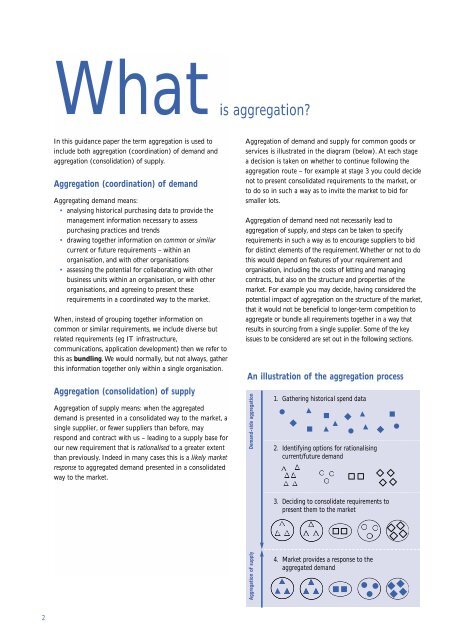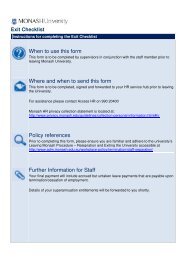Aggregation: Is bigger always better? - Eupian
Aggregation: Is bigger always better? - Eupian
Aggregation: Is bigger always better? - Eupian
You also want an ePaper? Increase the reach of your titles
YUMPU automatically turns print PDFs into web optimized ePapers that Google loves.
What isaggregation?In this guidance paper the term aggregation is used toinclude both aggregation (coordination) of demand andaggregation (consolidation) of supply.<strong>Aggregation</strong> (coordination) of demandAggregating demand means:• analysing historical purchasing data to provide themanagement information necessary to assesspurchasing practices and trends• drawing together information on common or similarcurrent or future requirements – within anorganisation, and with other organisations• assessing the potential for collaborating with otherbusiness units within an organisation, or with otherorganisations, and agreeing to present theserequirements in a coordinated way to the market.When, instead of grouping together information oncommon or similar requirements, we include diverse butrelated requirements (eg IT infrastructure,communications, application development) then we refer tothis as bundling.We would normally, but not <strong>always</strong>, gatherthis information together only within a single organisation.<strong>Aggregation</strong> (consolidation) of supply<strong>Aggregation</strong> of supply means: when the aggregateddemand is presented in a consolidated way to the market, asingle supplier, or fewer suppliers than before, mayrespond and contract with us – leading to a supply base forour new requirement that is rationalised to a greater extentthan previously. Indeed in many cases this is a likely marketresponse to aggregated demand presented in a consolidatedway to the market.<strong>Aggregation</strong> of demand and supply for common goods orservices is illustrated in the diagram (below). At each stagea decision is taken on whether to continue following theaggregation route – for example at stage 3 you could decidenot to present consolidated requirements to the market, orto do so in such a way as to invite the market to bid forsmaller lots.<strong>Aggregation</strong> of demand need not necessarily lead toaggregation of supply, and steps can be taken to specifyrequirements in such a way as to encourage suppliers to bidfor distinct elements of the requirement.Whether or not to dothis would depend on features of your requirement andorganisation, including the costs of letting and managingcontracts, but also on the structure and properties of themarket. For example you may decide, having considered thepotential impact of aggregation on the structure of the market,that it would not be beneficial to longer-term competition toaggregate or bundle all requirements together in a way thatresults in sourcing from a single supplier. Some of the keyissues to be considered are set out in the following sections.An illustration of the aggregation processDemand-side aggregation1. Gathering historical spend data2. Identifying options for rationalisingcurrent/future demand3. Deciding to consolidate requirements topresent them to the market<strong>Aggregation</strong> of supply4. Market provides a response to theaggregated demand2

















